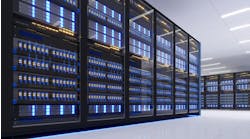Don’t Go It Alone: The Value of Trusted Data Center Partnerships
When it comes to scalability, partnerships can make or break your success in the data center world. In this edition of Voices of the Industry, Jim Levin, Vice President of Business Development, Strategy & Marketing, Instor Solutions Inc., explains how to identify the right strategic data center partnerships – and how to hang on to them.
Jim Levin, Vice President of Business Development, Strategy & Marketing, Instor Solutions Inc.
Over the years, the best partnerships have been built on a foundation of trust and dependability. But there’s one critical factor that’s often overlooked and it lies at the core of all the greatest partnerships: contrasting skillsets.
Imagine, for instance, Jobs without Wozniak. It was the combination of Steve Jobs’ marketing savvy and Steve Wozniak’s technical know-how that created the magic of the early days of Apple. The idea can be applied across the board – from data centers to cooking to everything in between. It’s the same reason sweet and savory foods go together so well or why a black and white photograph strikes such an emotional chord in the viewer: It’s all about managing and balancing a team’s contrasting skills and experience.
Whether you’re an end user, colocation provider, manufacturer, general contractor or a team of rapid deployment infrastructure expert like ours at Instor, there’s a single constant theme which requires you to properly scale your infrastructure: the ability to leverage partnerships and turn them into a win-win dynamic for both sides.
Let’s face it – none of us is an island. At some level, we all need to depend on valued and trusted partners to hit our goals. It’s not about individual weaknesses – it’s about leveraging the collective strengths of your partners to give your customers what they need to get ahead in today’s increasingly competitive environment. At the end of the day, each industry player is looking to scale its infrastructure. Even the top companies in the Fortune 500 leverage such partnerships to meet the needs of their end users every single day.
Working Across Geographic Regions
Our company, Instor Solutions Inc., designs and installs infrastructure solutions for data centers across the globe. We work closely with our clients to determine current and anticipated infrastructure needs on everything from build outs, to structured cabling, electrical design, relocation, migration and everything in between.
At Instor, we are frequently asked the question, “How do you manage multiple projects in so many geographic areas?” The answer is our trusted data center partnerships, and for very good reasons. Instor has an incredible team of knowledgeable, experienced industry veterans, but we also know that to successfully scale our project delivery model, we need to tap into our network of trusted specialty contractor partners to deliver consistent, on-time, quality installations.
Whether we leverage multiple electrical and structured cabling contractors in a specific market we’re working in, or bring the right specialty contractor to the site, it allows us to scale with our most demanding large enterprise or hyperscale projects. If you or your customer needs to build out significant data center infrastructure in multiple markets simultaneously – leveraging partnerships allows Instor to effectively be in all those places at once.
This same philosophy can be applied to our cloud/hyperscale customers in regard to their colocation data center partners. Let’s say your global data center capacity requirements top 250 megawatts, which is a very real possibility in 2018. When you have requirements like that, it’s nearly impossible to build your own data centers fast enough, so you might also have to leverage partnerships with colocation data center partners to achieve that scale. Having a colocation partner that is building the right kind of mission critical facilities, in the right market regions, and in realistic timeframes is indispensable to cloud and hyperscale customers.
Repeatability Matters
It’s also important to rely on trusted manufacturer partners to deliver products rapidly and consistently for both colocation providers and cloud/hyperscale customers. The ability to build and deploy substantially identical infrastructure over and over, and in different regions, reduces training costs, decreases downtime and substantially reduces human error.
In other words, strategic partnerships with colocation providers, contractors and suppliers make the impossible (i.e. massive scalability with consistent quality on tight timelines) possible.
There are five key elements to finding the right partners:
- Listening: Not just nodding-your-head-and-smiling listening, we’re talking about the lost art of really and truly listening. Listening takes experience, empathy, compassion and a mind that’s open to a flow of new information. Listening means giving your full, undivided attention and not simply waiting for the right moment to interject your own opinion.
- Asking questions: Detailed questions help you get to the heart of your customer’s true requirements, whether it’s related to capacity, power or deployment timelines. Probing until you find the customer’s pain points is a valuable skill, and it’s one worth cultivating.
- Transparency: Being open and honest is critical in all relationships. By keeping a two-way line of communication open at all times, you avoid making costly assumption.
- Shared sense of urgency: Your client’s challenges should become your challenges. This taps into a variety of skills including empathy, organization and prioritization of work.
- Mutual respect: You bring your strengths to the table, and so does your partner. By understanding and working with each other’s strong points, you’ll develop mutual respect and admiration and enjoy a better working relationship.
If you want to achieve the sort of massive scalability that’s called for in today’s data center world, you need to be open to strategic partnerships. Not only can these partnerships help you achieve your customers’ goals, but they’ll help you achieve yours as well.
Jim is Vice President of Business Development, Strategy and Marketing for Instor Solutions Inc.





